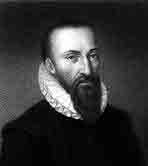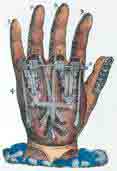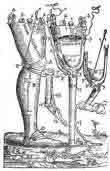Ambroise Pare
1510-1590
 Ambroise Pare was a French physician and one of the most renown surgeons of the European early modern period. Prior to Pare’s work as a surgeon, physicians considered surgery beneath their dignity, assigning the task to barber-surgeons.
Ambroise Pare was a French physician and one of the most renown surgeons of the European early modern period. Prior to Pare’s work as a surgeon, physicians considered surgery beneath their dignity, assigning the task to barber-surgeons.
At an early age, Pare served an apprenticeship to a barber-surgeon in the French provinces. In 1533 he went to Paris, where he continued his surgical training with a Parisian barber. In 1537 he took a job as army surgeon. He served intermittently in the army for the next 30 years, during which time he developed a flourishing surgical practice. He was known through his writings for his surgical discoveries as well as his kindly treatment of soldiers of all ranks. By 1552 he had gained such fame that he was appointed as the king Henry the second. He eventually served four French monarchs: Henry II, Francis II, Charles IX, and Henry III.
In the army Pare changed the treatment of gunshot wounds by dressing wounds with soothing ointments. This was a departure from the traditional use of boiling oil to cauterize the wounds. Pare also promoted ligature of the blood vessels to prevent hemorrhaging during amputations. Paré drew heavily from Andreas Vesalius's authoritative work on anatomy, basing his surgical decisions upon anatomical science.
In 1541, Pare published his invention of an obturator:
Many times it happeneth that a portion or a part of the bone of the palate, being broken by the shot of a gun, or corroded by the virulency of the Lues Venerea, falls away, which makes the patient to whom this happeneth that they cannot pronounce their words distinctly, but obscurely and snuffling; therefore I have thought it a thing worthy of labour to show how it may be helped by art. It must be done by filling the cavity of the palate with a plate of silver or gold, a little bigger than the cavity itself—on the upper side, which shall be turned towards the brain, a little sponge must be fastened, which, when it is moistened with the moisture distilling from the brain, it will become more swollen and puffed up, so that it will fill the concavity of the palate, that the artificial palate cannot fall down (Gould & Pyle, 1937; cited in Eldridge, 1968, p, 27).
Among Pare’s other medical inventions were (1) artificial limbs and movement mechanisms (see illustrations below), (2) an artificial eye, (3) an obturator for repairing cleft palates (4) a means for shifting of a fetus in utero to facilitate birth, and (4) a means for inducing labor in cases of uterine hemorrhage.


Pare’s inventions
Writings about Ambroise Pare
Williams, A. (2003). “Labor improbus omnia vincit”; Ambroise Pare and sixteenth century child care. Archives of Disease in Childhood, 88:985-989.
